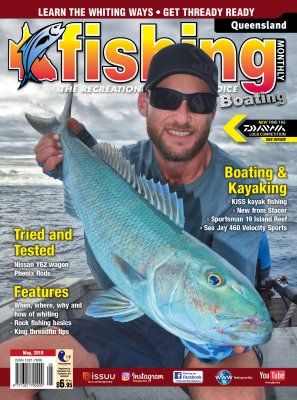King threadfin salmon: the sportfish of the future by Ryan McCosker
 King threadfin have always been thought of as more of a by-catch species in the Fitzroy - the fish you catch while targeting barramundi. Although in recent years, as knowledge and interest in the species has grown, they've started to become less of a pest and more of a sportfish. This has been helped along by a steady increase in numbers as a result of the recently implemented net-free zones.
King threadfin have always been thought of as more of a by-catch species in the Fitzroy - the fish you catch while targeting barramundi. Although in recent years, as knowledge and interest in the species has grown, they've started to become less of a pest and more of a sportfish. This has been helped along by a steady increase in numbers as a result of the recently implemented net-free zones.
King threadfin are most often caught by searching for large schools in deep water and casting vibes through the school with the current. However, they frequently breach the water in front of drains and bank slips. This article will provide a basic overview of the anatomy of a Fitzroy River king threadfin, and cover how to locate these edge-feeding fish, as well as how to target them.
King threadfin reside in large estuary systems across north Australia and southern PNG, and are found as far south as the Brisbane River. However, the main habitats for these fish on the east coast are large tidal rivers, particularly all throughout the Fitzroy, Mary and Brisbane river systems.
King threadfin can exhibit a great level of diversity in habitat, even throughout one river. In the Fitzroy, king threadfin can be found around the shallow rocks of the town reaches, right down to the strong current and deep water of Port Alma, the mouth.
Studies on the size and age of king threadfin from the Fitzroy, Mary and Brisbane river systems found that fish from each system are genetically isolated, with king threadfin from the Fitzroy growing significantly bigger and older than fish from the Mary and Brisbane rivers. All the available data shows that Fitzroy River fish live to up to 22 years and reach 1222mm fork length, compared to 10 years and 975mm and 14 years, and 1047mm for the Mary and Brisbane fish respectively.
This information is important in regards to the conservation of this species, as the legal limit for king threadfin is 600mm total length, which converts to roughly 490mm fork-length. This clearly needs to be changed, as this is significantly lower than the size of maturity in all three major systems, meaning fish can be taken well before they have a chance to contribute to the population as a male, let alone a female.
When it comes to anatomy and structure, king threadfin are in a league of their own. They are a long, slender fish with long and pronounced fins. They feature a large bump on their head that extends out past the lower jaw. Perhaps one of their most interesting features is the large filaments that extend from the throat of the fish. King threadfin have ten filaments in total, five on each side. Nobody is quite sure what they are used for; they could be used to help muster prawns and other bait up into the mud, or to feel around and pinpoint bait in murky water. Another theory is that they are used to detect vibration, working similarly to the lateral line.
There aren't really any concrete methods of locating edge-feeding king threadfin in the Fitzroy, as more often than not they can be spotted hard up against the bank in shallow water, such as bank-slips, drains, or creek mouths. Jelly prawns showering, as well as boils and bow waves in the shallow water, are dead giveaways of actively feeding king threadfin. It is also common for fish to breach the water or run themselves up onto the bank while herding prawns.
Keep in mind that the Fitzroy River has very strong tidal influences, so currents will force bait to congregate in swirling back eddies around structure, reversed currents along a shallow bank or into the mouths of drains. This makes for a perfect place for king threadfin to feed and is another